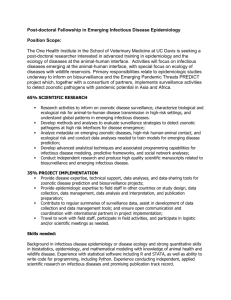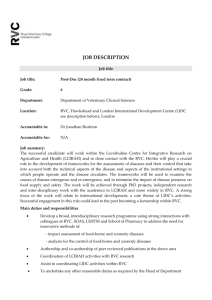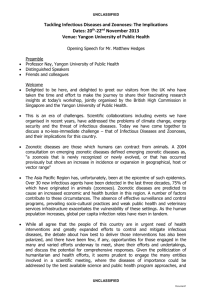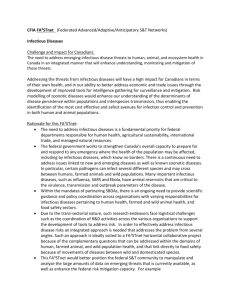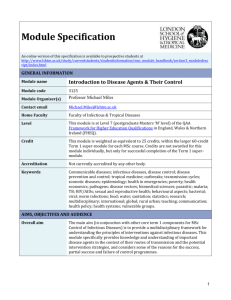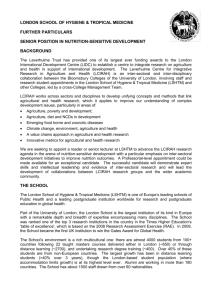Report from the LIDC workshop on Emerging Zoonotic Diseases
advertisement
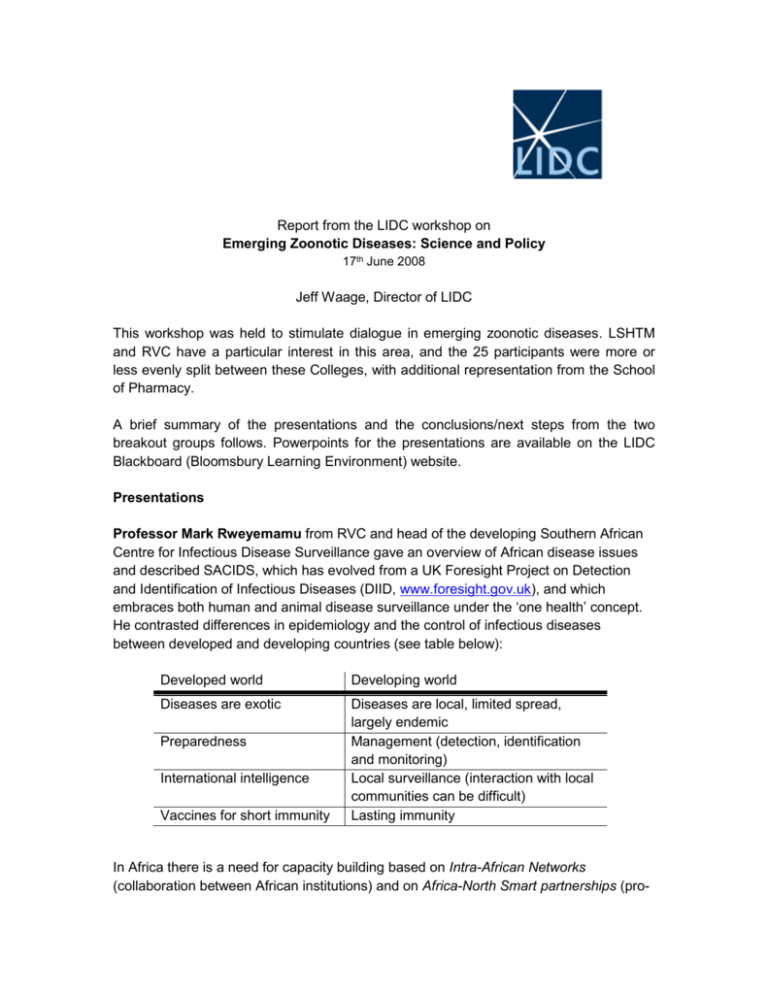
Report from the LIDC workshop on Emerging Zoonotic Diseases: Science and Policy 17th June 2008 Jeff Waage, Director of LIDC This workshop was held to stimulate dialogue in emerging zoonotic diseases. LSHTM and RVC have a particular interest in this area, and the 25 participants were more or less evenly split between these Colleges, with additional representation from the School of Pharmacy. A brief summary of the presentations and the conclusions/next steps from the two breakout groups follows. Powerpoints for the presentations are available on the LIDC Blackboard (Bloomsbury Learning Environment) website. Presentations Professor Mark Rweyemamu from RVC and head of the developing Southern African Centre for Infectious Disease Surveillance gave an overview of African disease issues and described SACIDS, which has evolved from a UK Foresight Project on Detection and Identification of Infectious Diseases (DIID, www.foresight.gov.uk), and which embraces both human and animal disease surveillance under the ‘one health’ concept. He contrasted differences in epidemiology and the control of infectious diseases between developed and developing countries (see table below): Developed world Developing world Diseases are exotic Diseases are local, limited spread, largely endemic Management (detection, identification and monitoring) Local surveillance (interaction with local communities can be difficult) Lasting immunity Preparedness International intelligence Vaccines for short immunity In Africa there is a need for capacity building based on Intra-African Networks (collaboration between African institutions) and on Africa-North Smart partnerships (pro- active participation of African countries). SACIDS is a Med-Vet consortium of institutions in African countries (DRC, Tanzania, Mozambique, Zambia) in partnership with RSA and UK (LSHTM, RVC, Edinburgh). He was asked how institutions in the SACIDS consortium will address the issue of intellectual property. Rweyemamu explained that outputs from different projects within the consortium will be considered shared among partners and courses will be open source. Dr. Sandra Mounier-Jack from the Communicable Disease Policy and Research Group at LSHTM described how she and Richard Coker have been looking at mapping preparedness for pandemic influenza in Europe, Asia, Africa and Latin America and analysed plans according to WHO guidelines. They have developed original methods for this, and recently extended this mapping to consider national preparedness to operationalise action in the event of a pandemic. This work has had a positive effect – countries rated to be at a low state of preparedness reacted by taking measures to improve their status. The studies have found: Poor linkage between human and animal disease Preparedness for pandemic flu in Africa is multisectoral, focused on local outbreaks and containment, with no antiviral or vaccine strategies. Asiaflucap, a new project mapping resources for responses to pandemics in Southeast Asia, sponsored by Rockefeller and EU, also looks at technical and governance strategies. There is a need in many countries to identify stewardship and political ownership of infectious disease threats, and to see consistency in response. Evidence of successful public health interventions is limited, and commitment to preparedness and acting in the public good (i.e. cooperation) needs improvement. Professor Katharina Stärk from the Division of Veterinary Public Health (RVC) spoke on foodborne zoonotic diseases and disease risk, and described the complex factors which affect this, including urbanisation, the livestock revolution, changes in diet and international trade. Advances in this field include: Molecular epidemiology, which has permitted tracking of the source of human infections, e.g. from wild or domestic animals or environment. Risk analysis (risk assessment and risk management and risk communication), which is becoming widespread as a result of WTO and its Sanitary and Phytosanitary agreements. WTO operates on the principle that trade is free unless you can show risk in a scientific manner through risk assessment. Risk analysis is being used to guide surveillance, leading to new risk-based designs for surveillance. Of the parts of risk anaylsis, risk communication is still not well developed, and the concept of risk analysis generally has to be developed/improved in developing countries). On zoonotic diseases, Stärk observed the growth in interest and training in Veterinary Public Health, which encompasses the sum of veterinary contributions to public health, particularly in USA and Canada, where ‘one health’ is also most popular. RVC has established a new Centre for Emerging, Exotic and Endemic Diseases (CEEED) in a new facility on their Hawkshead Campus. This will house staff from a range of disciplines, including epidemiology, and a socio–economist has been recruited. CEEED will have an interdisciplinary brief, and will focus on complex infectious disease systems and emerging and vector borne diseases. Professor Paul Fine at LSHTM reported on his recent study of the eradication of human and animal diseases. He described the six programmes that have been undertaken in global disease eradication, and why most of them have failed. So far, only smallpox eradication has been successful, but rinderpest is likely, as is guinea worm, in the next few years. Polio eradication is still problematic. He made a case for considering eradication initiatives at this time: Emerging infectious diseases may be fashionable now in the wake of SARS and avian influenza but will be subject to declining interest Eradication campaigns demonstrably build funds, infrastructure and morale, although failures like yaws and malaria have equal opposite effects on confidence in public health. By 2010, FAO will probably announce rinderpest and WHO guinea worm eradication, creating an opportunity for new enthusiasm and investment, so LIDC should develop a meeting in advance to target other opportunities for global eradication. Professor Joe Brownlie of RVC described a ‘one health’ initiative in Tanzania designed last year and submitted to Wellcome Trust for strategic funding, and discussed why this proposal failed, as a lesson to future zoonotic proposals. There was strong interest in the host institutions in Tanzania. He observed that a number of staff in the medical institute in Dar es Salaam were actually vets by training. Insufficient involvement of human health experts was a principle reason for failure – something to ensure is not the case in future proposals. Dr. Matthias Borchert at LSHTM discussed viral haemorrhagic fevers in Africa. He focused on rodent-borne Lhasa fever in West Africa, where he is working with the Natural Resources Institute (rodent control experts) in Sierra Leone. Most of his talk focused on Marburg/Ebola viruses in Central Africa. These are almost certainly from bats, but contaminate man also through the bushmeat trade. While outbreaks are local and sporadic, the frequency of these has increased dramatically since 1990 and now there are almost yearly outbreaks. Forest clearance may be a factor. While there is considerable international interest in surveillance for these diseases, and hence some activity, there has been a nearly complete breakdown of surveillance at local and regional level. Hence new outbreaks may take a long time to be reported, affecting many people before international groups get involved and act quickly. The use is actively producing vaccines for these diseases due to their concern about bioterrorism. The principle factor causing infection in outbreaks of these viruses is not primary transmission but nosocomial infection associated with hospitals and through care transfer, e.g. handling of the deceased. In this way, a very small number of initial infections can disrupt whole health systems. This has been exacerbated by insensitive treatment of local communities by outside medical groups which enforce isolation of the disease. This has been realised and anthropological studies have helped organisations like Médecins Sans Frontières to modify their interventions. There are a number of areas where new research could improve action against these diseases: Better understanding of bat-human interactions and epidemiology (frequency of contacts, risk groups, avoidability) Anthropological studies to improve management outbreaks Socioeconomics of disruption – demonstrating the broader impact Applied research to improve hospital hygiene and preparedness Improvement of outbreak prevention and response. Capacity building for sustainable improvement. Dr Javier Guitian from RVC described the work in the Division of Veterinary Epidemiology which he and Dirk Pfeiffer are carrying out on avian influenza management and policy, through programmes focused on developing countries and involving DFID, FAO, the International Food Policy Research Institute, the International Livestock Center (Nairobi) and University of California at Berkeley. More generally the group is particularly interested in research into spatial epidemiological modelling of diseases like TB and avian influenza and the use of modelling in risk assessment. Their projects combine applied research, capacity building and policy support. The DFID programme in African and Asia is focused on participatory approaches, addressing the problem that most avian influenza work has been top down and has avoided smallholder (e.g. poultry producer) engagement and indirectly disempowered this constituency. The group is also working on Peste des petits ruminants in Africa, Brucellosis in Egypt, and herd health programs for smallholders in Bolivia. There is a joint PhD project between LSHTM-RVC PhD working on HPAI in food chain in Vietnam focusing on participatory epidemiology and the public health dimensions of livestock, with a strong socioeconomic approach. Professor Tony Barnett at the LSE (and also a visiting Professor at LSHTM) gave an overview of social perspective on infectious diseases to stimulate the group in discussing this issue in breakout sessions. He described how infectious disease studies interact with social science in a series of traditional, rather limiting ways: Cost benefit assessment (i.e. for Infectious disease control study) Opinion surveys (and US behavioural science tradition) Large scale economic modelling Shifted thinking about infectious diseases from risk behaviour (focused on individuals) to risk environment. He described how infectious disease studies can under-use or mis-use social sciences research. Often, social science is often dragged into for analysing the results of infectious diseases research (end of pipe work) or involved superficially in its initial design. Social science arguments are often made without proper evidence, for instance in attempts to link HIV AIDS severity to fragile states or poverty, and more generally where social science arguments are constructed for reasons of advocacy reasons. He described his hypothesis that different infectious diseases, due to their difference biology and epidemiology, inscribe different ‘signatures’ on society, and that understanding this can provide insight into disease management. In his view, social science interacts best with infectious disease research where interdisciplinary social science meets demography and epidemiology. His group is currently building up a “bibliography” of published research on infectious diseases that have components of social science. Breakout Groups The two breakout groups were asked to consider what were the important aspects of emerging zoonotic diseases for research and where Bloomsbury Colleges could contribute, with a particular emphasis on interdisciplinary research and the engagement of social sciences. Each was asked to suggest up to five initiatives for LIDC to support. Group 1 1. Bloomsbury based training to learn about social science and disease – to understand concepts and their application – a series of meetings, lectures, perhaps charging a fee? 2. Training in one health – generic skills for research or masters level – scientists and politicians. 3. Anti-microbial resistance – this subject links LSHTM, RVC, and SoP – has many dimensions, economics, science, policy, development – a great deal has been done, so there would need to be a study first on our comparative advantage and areas of focus – employ someone to do this? 4. A conference on eradication of human and animal diseases, in anticipation of declaration of rinderpest and guinea worm, to launch new initiatives or discuss. Get key people together from international organisations and academia. Relate it to the contemporary situation – the Gates goal of eradicating malaria. 5. Generally, Colleges could create a platform of basic skills and high tech tools for infectious diseases. Hard to predict next pathogen so create a skills platform to deal with all of them and support an accelerated response capacity. 6. A social science project on animal and human disease management and policy, to explore the extent to which animal health and human health (experts) are currently ‘working’ together and their reasons, and to measure what the impact of this behaviour is on the speed of response to emerging zoonotic threats. Do a comparison based on experience of avian influenza worldwide? Group 2 Within a framework of the MDGs/Human Rights so as to situate the research more widely and certainly in relation to international development issues and possibly in relation to some estimate of the burden of infectious diseases (suggested by Daniel Chandramohan of LSHTM), this is a project looking at migration and demography and the identification of possible sites for the appearance of emerging diseases particularly through zoonoses. An obvious area of focus would be urban cattle keeping. The goal of the project would be that in identifying key processes we would be able to begin to make suggestions as to prevention responses and foci. This project might well be informed by the ‘one medicine’ approach and would include elements of both monitoring and prevention. It would combine both natural and social sciences. 1. The policy-research interface: the key here is learning from the veterinary world where combinations of wider (meaning economic, political and social) systems and clinical case studies are common modes of proceeding. The focus of this project would be to look at the ways in which research findings are translated into policy outputs and would take as one of its concerns the question of what constitutes evidence in an environment where the RCT is taken as the gold standard for research and where such research protocols may serve to exclude social science inputs to the development of research projects. 2. A study of the interactions between diseases in the human population and their effects on animal health. An obvious one here would be to look at HIV morbidity and mortality and ask what have been the effects of this on animal health and production in some African pastoral communities. While HIV is the obvious one, other chronic disease might be included, particularly TB which is in any case closely associated with AIDS. 3. To develop a capacity based in LIDC to provide consultancy personnel for research projects and also possibly for others combined with a facility to enable “experts” from the group to be made available to the media. Would require some admin support at first but quite quickly would require some proactive work on the part of the person doing the job. Also would require that group members be available if asked! 4. A mixed social-natural science conference to look at zoonotic diseases and human health/livelihood. This could easily be combined with the other group’s adoption of Paul Fine’s suggestion of a conference on disease eradication. Funders and Stakeholders should be invited, but probably should be necessary to create an idea/topic in order to be able to ask for their support. 5. Development of some modules to add to the existing and successful LSHTM – RVC masters degree. These modules would deal with (a) zoonoses and (b) development issues and thus provide a ready available capability where training components were required to be provided as part of research projects. Final Comments While some of the ideas above need development and focusing, there are a number of potential initiatives which LIDC can champion. We will look at this in July and get back to you on what we propose. The SACIDS project, which Mark described, is up and running, and LSHTM, RIVC and other Colleges where appropriate, can contribute immediately to an interdisciplinary research and training activity through becoming involved in the proposals for this project to interested donors. Please let Jeff Waage of LIDC and Silvia Alonso of RVC know if you have any further thoughts or would like to help develop any of the ideas above. We would be particularly keen to hear from those who were interested but could not attend.

